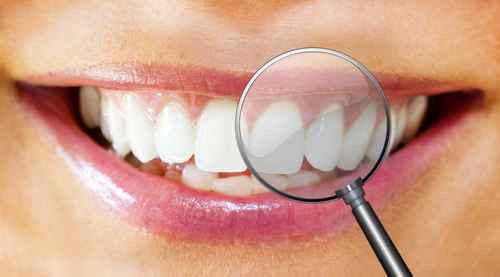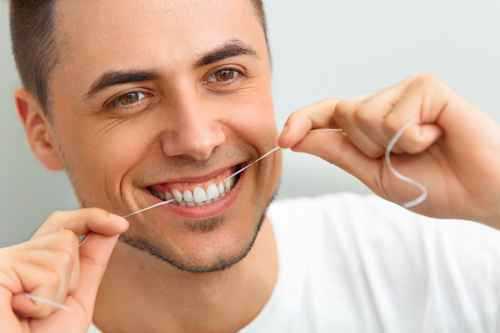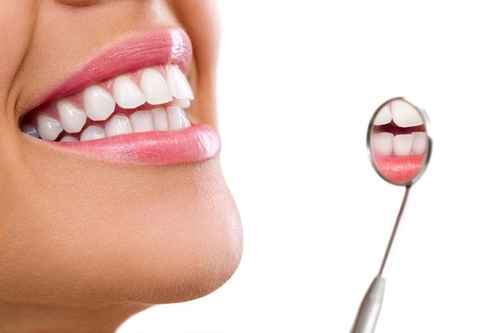The Connection Between A Beautiful Smile & A Healthy Body
Vibrant Health Begins In The Mouth
A smile is a beautiful curve that sets a lot of things straight and is the shortest distance between two people.
To watch my Webinar entitled ORAL CARE: Healthy Mouth ~ Healthy Body,
please click HERE.
 We all share in a common desire, which is to be healthy and to have a good quality of life. We also know that a proper diet, exercise and the proper amount of rest contribute to our well-being. But did you know that vibrant health really begins in the mouth? How you care for your teeth and gums has a direct impact on your overall health. Recent studies and reports have confirmed a frequent oversight of importance to our health, which is the care we give to our teeth and gums. While a beautiful smile and fresh breath have been our main pursuits, let’s extend our focus to include the gums. And even though I am not a dentist, I have conducted extensive research on the connection between a healthy mouth and a healthy body and have given many talks on the subject. In a nutshell, here are some of the things that I’ve discovered (Healthy Mouth 101) about the connection between a healthy mouth and body.
We all share in a common desire, which is to be healthy and to have a good quality of life. We also know that a proper diet, exercise and the proper amount of rest contribute to our well-being. But did you know that vibrant health really begins in the mouth? How you care for your teeth and gums has a direct impact on your overall health. Recent studies and reports have confirmed a frequent oversight of importance to our health, which is the care we give to our teeth and gums. While a beautiful smile and fresh breath have been our main pursuits, let’s extend our focus to include the gums. And even though I am not a dentist, I have conducted extensive research on the connection between a healthy mouth and a healthy body and have given many talks on the subject. In a nutshell, here are some of the things that I’ve discovered (Healthy Mouth 101) about the connection between a healthy mouth and body.
When someone smiles at you, or you smile in the mirror, what do you see? For most, you see teeth and part of the gums all surround by lips. Your teeth make it possible for you to chew your food, and they are held into place by your gums. The main function of the gums is to protect the teeth. Your teeth are designed to last a lifetime; it’s gum disease, also known as periodontal disease that would cause you to lose your teeth. We all like to see perfectly aligned and straight teeth when we look in the mirror or at other people.
 While your eyes are the windows of the soul, your teeth reflect your level of health and vitality. That’s why teeth whitening and straightening are more popular than ever in America, and it’s now catching on in other areas like the UK, Canada, and Australia. America always seems to be the harbinger for all-things healthy as well as cutting-edge advances, including dental advances. To have attractive, healthy-looking teeth also represents, for most people, a higher level of success and prosperity. In my Rejuvenation & Appearance Makeover consultations and workshops throughout America and worldwide (as well as on countless talk shows), I always recommend to start with your teeth. It’s not expensive to whiten your teeth or get invisible braces, which are very popular with adults these days, and even with people in the 40s through 60s. The reason is simple; both work effortlessly. Whitening and straightening work immensely well and can make a profound difference in how someone looks and feels about him or herself.
While your eyes are the windows of the soul, your teeth reflect your level of health and vitality. That’s why teeth whitening and straightening are more popular than ever in America, and it’s now catching on in other areas like the UK, Canada, and Australia. America always seems to be the harbinger for all-things healthy as well as cutting-edge advances, including dental advances. To have attractive, healthy-looking teeth also represents, for most people, a higher level of success and prosperity. In my Rejuvenation & Appearance Makeover consultations and workshops throughout America and worldwide (as well as on countless talk shows), I always recommend to start with your teeth. It’s not expensive to whiten your teeth or get invisible braces, which are very popular with adults these days, and even with people in the 40s through 60s. The reason is simple; both work effortlessly. Whitening and straightening work immensely well and can make a profound difference in how someone looks and feels about him or herself.
Put simply, teeth whitening and straightening is an inexpensive way to boost self-esteem and confidence and, as I have discovered in my countless consultations, helps one increase his or her level of prosperity; these simple teeth-enhancing processes reflects positively on all levels of one’s life. But let’s move past this fine-tuning discussion of our choppers, and go deeper than at-first-glance impressions.
 The nation’s first-ever comprehensive study detailing the definitive link between poor oral health and the onset of serious life-threatening illnesses was reported by the Surgeon General of the United States and was issued on May 25, 2000. Entitled Oral Health in America, it makes for fascinating reading. Here’s a brief summary. According to the report, periodontal disease affects 75% of adults and has been linked to numerous life-threatening illnesses, including heart and lung disease, stroke, diabetes, anemia, hemophilia, oral cancer, kidney disease, low birth weight and premature births.
The nation’s first-ever comprehensive study detailing the definitive link between poor oral health and the onset of serious life-threatening illnesses was reported by the Surgeon General of the United States and was issued on May 25, 2000. Entitled Oral Health in America, it makes for fascinating reading. Here’s a brief summary. According to the report, periodontal disease affects 75% of adults and has been linked to numerous life-threatening illnesses, including heart and lung disease, stroke, diabetes, anemia, hemophilia, oral cancer, kidney disease, low birth weight and premature births.
What a shocking statement. Before I began my extensive research, I wondered about the following: How can periodontal disease have this kind of effect on our overall health? How can we identify this disease? And how can we rectify it?
The Riveting Story of Plaque
The story begins with plaque, the sticky substance that develops on the surface of the teeth. But what is plaque? Simply put, it is a combination of bacteria, proteins and minerals that are in our saliva. Proteins and minerals provide a self-sufficient world for the bacteria. The minerals fixate to the tooth’s surface (above the gum line and below the gun lime), providing bacteria with a place to adhere. The proteins provide food for the bacteria. Bacteria are living organisms; they eat and digest just as we do. It is the toxins within their waste that can present problems. Now don’t be alarmed; bacteria have their common place within us; they assist in our digestive process. It is when we do not provide a clean environment for them to live, that we have problems. (Please refer to my previous article on internal cleansing that appeared in the March issue.)
 Periodontal disease starts under the gums, as a result of neglecting these toxins. This is the first stage of periodontal disease, referred to as gingivitis. Gingivitis is the most common among the population and the most overlooked. The gums become inflamed and start to bleed. Please note that it is here, at this point, that your cleaning efforts are most important to circumvent further problems.
Periodontal disease starts under the gums, as a result of neglecting these toxins. This is the first stage of periodontal disease, referred to as gingivitis. Gingivitis is the most common among the population and the most overlooked. The gums become inflamed and start to bleed. Please note that it is here, at this point, that your cleaning efforts are most important to circumvent further problems.
Now how can this affect our overall health? This can be best understood with the following simple example. Most people are familiar with instructions that are given to the heart patients when they experience chest pains, which is to take a nitro-glycerin tablet. Where does the doctor instruct the patient to place the tablet? Under the tongue—because there is a series of blood vessels under the tongue that allow this medication to enter the blood stream more rapidly, thereby quickly affording the patient the relief he seeks. The main functions of the blood stream are to rid the body of toxins and to transport oxygen and nutrients to heal and energize the body. As I elucidate in my books, Wired for High-level Wellness, Uplifted, and Hug in a Mug, if toxic build-up is greater than its riddance, these toxins can find their way to vital organs, and this is the basic link between periodontal disease and how it can affect our overall health.
Update Your Personal Home Dental Care Program
Your personal home dental care is the best defense you have against periodontal disease. Regular dental visits are very important, but even if you visited your dentist four times a year, that still leaves 361 days each year that you are individually responsible for your oral health. Your dental professional can provide you with important services, such as regular cleanings, examinations, monitoring and education. This will equip you in establishing an effective home care program. A practical approach to your personal dental care will increase your consistency. Let’s look at the most familiar home dental tools, their strengths and how they are best used.
 The Toothbrush disrupts sticky plaque on the visible surface of the tooth (above the gum line). Whether using a manual or powered toothbrush, always make a conscious effort to brush the buckle side of the teeth (which is next to the cheek), the lingual side (next to the tongue) and the back quadrants of the mouth (most overlooked area). Schedule at least two minutes to brush your teeth for adequate cleaning. A toothbrush is very efficient in breaking up (disrupting) the plaque, but only minimal in collecting it. I floss while taking a shower, with the water running on my back; it’s relaxing, easy and enjoyable.
The Toothbrush disrupts sticky plaque on the visible surface of the tooth (above the gum line). Whether using a manual or powered toothbrush, always make a conscious effort to brush the buckle side of the teeth (which is next to the cheek), the lingual side (next to the tongue) and the back quadrants of the mouth (most overlooked area). Schedule at least two minutes to brush your teeth for adequate cleaning. A toothbrush is very efficient in breaking up (disrupting) the plaque, but only minimal in collecting it. I floss while taking a shower, with the water running on my back; it’s relaxing, easy and enjoyable.
Dental Floss will effectively disrupt sticky plaque and remove food debris from in-between the teeth. Wind approximately 16 inches of floss around the middle fingers of each hand. Carefully position floss between the tooth; strive not to force between the teeth. Curve the floss around the side of the tooth in a “C” formation. Gently slide the floss under the gum, then scrape away from the gum several times. By pulling downward you ensure to not push the disrupted plaque under the gums. Floss each tooth in this manner. Dental floss is also very efficient in disrupting the plaque, but minimal in collecting it.
An Oral Irrigator, my favorite oral care device/practice, delivers a stream of pulsating water to disrupt and flush plaque from the mouth. It is a great tool to follow up after brush and flossing, as it will flush out the disrupted plaque that those tools leave behind. An oral irrigator will flush under the gums where bacterial infection is most prominent. The system consists of a pump, motor, water reservoir, jet tips, hose and handle. Direct the stream of water towards the surface of the tooth and follow along the margin of the gum line and in-between the teeth. Irrigate both sides of the teeth. Schedule at least two minutes to irrigate your teeth for adequate cleaning. Because I have sensitive teeth and gums, I use warm water in my oral irrigator and generally add some kind of natural (without artificial ingredients or preservatives) mouthwash.
 There are a variety of tools available to assist you for better oral health; the main objective is to find what works best for you and your schedule. Education will be your greatest tool, as it will reinforce and move you to action. Do your own research, ask your dental professional questions and gather information, just as you are doing now by reading this article. This is the beginning of your success.
There are a variety of tools available to assist you for better oral health; the main objective is to find what works best for you and your schedule. Education will be your greatest tool, as it will reinforce and move you to action. Do your own research, ask your dental professional questions and gather information, just as you are doing now by reading this article. This is the beginning of your success.
An Overall Balanced Program
Let’s look at one last foundational concept, in your pursuit of excellent overall and oral health. It’s one that you’ve heard all about if you’ve read any of my previous articles or books, which is to get the adequate amount of rest, regular exercise, and eat a well-balanced diet. In my pursuit of oral care education, not surprisingly I’ve learned that the similarity of wisdom to achieve good overall health is the same to obtain good oral health, thus further confirming the link between the two.
We often hear that it’s important to drink at least 8 glasses of water each day to maintain proper hydration, but did you know that it also neutralizes the plaque in your mouth? Additionally, water helps remove food debris from in between the teeth, if gently swished. And don’t forget calcium to build strong bones... and teeth, too.
 Rest and ample sleep provides an opportunity for the body to rejuvenate on a deep cellular level. It’s essential so that the body can repair, detoxify and renew, as well as replenish the energy lost during the day. Relaxation, different than deep sleep,can be accomplished by practicing calm deep breathing, which is a great way to reduce daily stress. So be sure to nourish your body with plenty of healing sleep, rest and relaxation. When you are stressed out, overwhelmed by obligations and living a less-than-balanced life, you might forget to spend the few minutes that are necessary each day to attend to your oral care. In other words, you relegate oral care to the back burner when, in all honesty, it needs to be a non-negotiable quotidian practice, just like sleep, exercise, optimum diet and a grateful, positive attitude.
Rest and ample sleep provides an opportunity for the body to rejuvenate on a deep cellular level. It’s essential so that the body can repair, detoxify and renew, as well as replenish the energy lost during the day. Relaxation, different than deep sleep,can be accomplished by practicing calm deep breathing, which is a great way to reduce daily stress. So be sure to nourish your body with plenty of healing sleep, rest and relaxation. When you are stressed out, overwhelmed by obligations and living a less-than-balanced life, you might forget to spend the few minutes that are necessary each day to attend to your oral care. In other words, you relegate oral care to the back burner when, in all honesty, it needs to be a non-negotiable quotidian practice, just like sleep, exercise, optimum diet and a grateful, positive attitude.
Enjoy your health and SMILE! Smiling seems to always carry with it a feeling of euphoria and optimism. A smile changes the way you feel and outwardly promotes a positive environment. Smiles are contagious. Do your own experiment; smile at the few people you see and experience smiles in return. Studies reflect that those who smile and are optimistic, fight illnesses better, live longer and have a better quality of life.
So it is true, there is a link between our overall health and our oral health and you can prove it with your smile.


